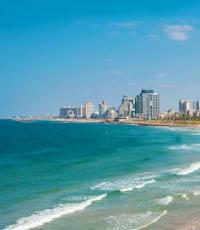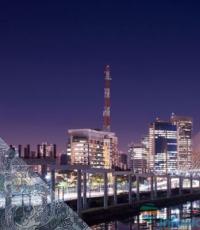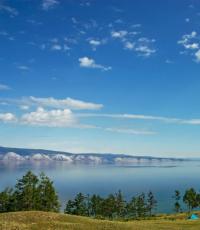Memorial sign "Arrow of Vasilyevsky Island". Memorial sign "Arrow of Vasilyevsky Island" New stages of transformation
Spit of Vasilyevsky Island in St. Petersburg. A beautiful and harmonious architectural ensemble on the eastern tip of Vasilievsky Island, formed by the Exchange, Rostral Columns, Exchange Square, customs buildings, southern and northern warehouses in the first half of the 19th century according to the design of J.-F. Thomas de Thomon and I. F. Luchini.
The territory of the present Strelka remained undeveloped for a long time, despite the fact that Vasilievsky Island itself began to be actively developed at the beginning of the 18th century under Peter I. First, the city port was moved here, but later it was shifted to the north. The first plan for transforming the square was adopted in 1767, however, the first building - the majestic Bourse building - was erected by the architect J.-F. Thomas de Thomon only in 1805-1810, at the same time the Rostral columns appeared here. The buildings, spreading out with wings towards the Exchange, were built in 1826-1832, with their appearance the Strelka ensemble was finally formalized.
The famous semicircular ledge of the Strelka is of artificial origin - for its arrangement, soil was added to the river bed, which increased the length of the cape by 123.5 meters towards the river. Initially it was intended for the front pier of the seaport, but in 1894 it was decided to organize a small garden with vases, paths and benches on it. The modern park on Strelka was created in 1925-1926 according to the design of L. A. Ilyin.
The Spit of Vasilyevsky Island is one of the most favorite places for citizens and guests of the city; this beautiful place fascinates with its harmonious unity of water space and urban architecture. It is clearly visible both from the Peter and Paul Fortress and from the Trinity Bridge, as well as from pleasure steamers and boats. Panorama of Strelka is one of the most recognizable views of St. Petersburg.
During the Leningrad Siege, the crew of anti-aircraft batteries was located on Strelka.
The arrow of Vasilyevsky Island with the Exchange building is depicted on the Russian 50-ruble banknote.
In 2006-2009, the largest floating singing fountain in Russia operated near the Spit of Vasilyevsky Island.
The St. Petersburg wedding tradition is also connected with the Vasileostrovskaya Strelka - newlyweds must break a bottle of champagne on the quay wall so that the family voyage will be long and happy.
Note to tourists:
A visit to the Spit of Vasilievsky Island will be interesting for tourists interested in the architecture of the first half of the 19th century, and can also become one of the points of the excursion program while exploring the neighboring attractions included in the architectural ensemble - the buildings of the northern and southern warehouses (where the Central Museum of Soil Science is located, respectively). and Zoological Museum). In addition, next to the Spit of Vasilyevsky Island there are
Spit of Vasilyevsky Island- cape in the eastern part of the island, washed by the river. Bolshaya Neva and Malaya Neva. At the end of the 16th century. on this territory there was a small village; in 1703 there was an artillery battery of Vasily Korchmin, an associate of Peter I. In the 1700s. on the N.E. o...
ARROW- 1) a narrow alluvial strip of land, a long spit of sand, shell rock, gravel, protruding towards the sea (for example, the Arabat Spit in the Crimea). 2) A piece of land, usually in the form of a sharp wedge between two merging rivers, or the end of an island at … … Big Encyclopedic Dictionary
Islands- Islands. A significant part of Leningrad is located on the islands of the Neva delta. The city center is located on Admiralteysky Island. Islands close to each other form groups: islands of the Petrograd side (Petrogradsky Island, Aptekarsky Island, ... ... Encyclopedic reference book "St. Petersburg"
Islands- A significant part of Leningrad is located on the Neva delta. The city center is located on Admiralteysky Island. Islands close to each other form groups: islands on the Petrograd side (Petrogradsky Island, Aptekarsky Island, Petrovsky ... ... St. Petersburg (encyclopedia)
arrow- And; pl. genus. lok, dat. lkam; and. 1. Decrease to Arrow (1 2 digits). 2. A thin and narrow plate rotating on an axis with a pointed end, serving as an indicator of something. in various measuring instruments. Hour, minute, second. S. compass,... ... encyclopedic Dictionary
Petersburg Islands
St. Petersburg Islands- There is no clarity about how many islands there actually are in St. Petersburg. As of 2002, there are 33 islands with an official name. In addition, in the Gulf of Finland there is the so-called Kronstadt Archipelago ... Wikipedia
ARROW- 1. A cape or part of a territory that looks like an acute angle between 2 merging rivers. 2. Part of the island (for example, in Leningrad, the upper part of Vasilyevsky Island and the lower part of Kamenny Island), which has the appearance of an acute angle in plan. 3. Long narrow... ... Geological encyclopedia
ARROW- ARROW, and, female. 1. see arrow. 2. A thin and narrow plate rotating on an axis, serving as a pointer in various measuring instruments, watches. S. compass. Minute s. 3. A sign in the form of a line, two short ones extend from the end to the swarm at an acute angle... ... Ozhegov's Explanatory Dictionary
Arrow- Arrow: Arrow symbol "→". Arrow pointer, for example in a clock (clock hand), in dial gauges. Strelka is a dog cosmonaut who successfully returned from an orbital flight. The arrow is at the confluence of two or ... Wikipedia
Spit of Vasilyevsky Island (St. Petersburg, Russia) - description, history, location, reviews, photos and videos.
- Last minute tours in Russia
Previous photo Next photo


The Spit of Vasilyevsky Island - one of the oldest landmarks of St. Petersburg - was founded during the time of Peter I as a business, educational and government center of the city. According to the design of the Italian D. Trezzini, palaces for noble families, Gostiny Dvor and the Kunstkamera were founded here in 1716. In the 30s In the 18th century, a port was founded on Strelka, and the manor's palaces were occupied by the exchange, customs and warehouses. After 100 years, the exchange building was rebuilt by the French architect J. F. Thomas de Thomon. The Kunstkamera, or Cabinet of Curiosities, is still in operation today.
What to see
The Strelka panorama is a favorite subject for postcards and photo shoots. In the center it is decorated with the stock exchange building with a colonnade, on the sides there are former warehouses, where the Zoological Museum and the Museum of Soil Science are now located. The highlight of this place is given by the rostral columns, which served as beacons and a reminder of the naval victories of the Russian Empire.
There is a square on Birzhevaya Square, in the center of which lies the anchor of the Peter the Great era, and a little further there is a memorial sign in honor of the 300th anniversary of St. Petersburg. Trees with ball-shaped crowns are planted along the perimeter of the embankment. The Strelka offers a magnificent view of the Neva, Palace Embankment, and the Hermitage; it’s the best place to watch the fireworks from here.
Practical information
Address: St. Petersburg, Birzhevaya sq. Coordinates: 59.944259, 30.307137.
How to get there: by car - from Moskovsky railway station along Nevsky Prospect and Palace Bridge; from the Admiralteyskaya metro station 15 minutes on foot or by bus No. 5M, 191, trolleybus No. 7 (2 stops).
Cape in the eastern part of the island, washed by the river. Bolshaya Neva and Malaya Neva. At the end of the 16th century. on this territory there was a small village; in 1703 there was an artillery battery of Vasily Korchmin, an associate of Peter I. In the 1700s. on the N.E. o...
1) a narrow alluvial strip of land, a long spit of sand, shell rock, gravel, protruding towards the sea (for example, the Arabat Spit in Crimea). 2) A piece of land, usually in the form of a sharp wedge between two merging rivers, or the end of an island at ... ... Big Encyclopedic Dictionary
Islands- Islands. A significant part of Leningrad is located on the islands of the Neva delta. The city center is located on Admiralteysky Island. Islands close to each other form groups: islands of the Petrograd side (Petrogradsky Island, Aptekarsky Island, ... ... Encyclopedic reference book "St. Petersburg"
A significant part of Leningrad is located on the Neva delta. The city center is located on Admiralteysky Island. Islands close to each other form groups: islands on the Petrograd side (Petrogradsky Island, Aptekarsky Island, Petrovsky ... ... St. Petersburg (encyclopedia)
AND; pl. genus. lok, dat. lkam; and. 1. Decrease to Arrow (1 2 digits). 2. A thin and narrow plate rotating on an axis with a pointed end, serving as an indicator of something. in various measuring instruments. Hour, minute, second. S. compass,... ... encyclopedic Dictionary
There is no clarity about how many islands there actually are in St. Petersburg. As of 2002, there are 33 islands with an official name. In addition, in the Gulf of Finland there is the so-called Kronstadt Archipelago ... Wikipedia
1. A cape or part of a territory that looks like an acute angle between 2 merging rivers. 2. Part of the island (for example, in Leningrad, the upper part of Vasilyevsky Island and the lower part of Kamenny Island), which has the appearance of an acute angle in plan. 3. Long narrow... ... Geological encyclopedia
ARROW, and, female 1. see arrow. 2. A thin and narrow plate rotating on an axis, serving as a pointer in various measuring instruments, watches. S. compass. Minute s. 3. A sign in the form of a line, two short ones extend from the end to the swarm at an acute angle... ... Ozhegov's Explanatory Dictionary
Arrow: Arrow symbol "→". Arrow pointer, for example in a clock (clock hand), in dial gauges. Strelka is a dog cosmonaut who successfully returned from an orbital flight. The arrow is at the confluence of two or ... Wikipedia
Before flowing into the Gulf of Finland, the Neva spreads into many small rivers, forming a large number of islands. St. Petersburg is located on these islands.
In the very center of the city is Vasilyevsky Island, the largest island in the Neva delta with an area of 10.9 km 2.

The Spit of Vasilievsky Island, on which the Exchange building and Rostral columns are located, is one of the must-see attractions of the city. And not only because these are structures that form the architectural appearance of the city, but also because it is almost impossible to pass them.

The Exchange building was built in 1805 - 1810 by the architect Thomas de Thomon.

On the façade of the exchange building there is a sculptural composition headed by Neptune. After all, there was trade here in goods delivered to the city via the Baltic Sea.

In front of the exchange building, the architect installed Rostral columns, personifying the power and greatness of the Russian fleet.

On the columns there are symbolic bows of ships - “rostras”, symbolizing defeated enemy ships.

Until 1885, the rostral columns served as lighthouses marking the edges of the island in fog and darkness. There is no need for this now.

But in honor of major holidays, fires are lit on the columns.

The Central Naval Museum has been located in the Exchange building since 1939.

Since the beginning of 2000, it was decided to move the museum and disputes began about the future purpose of the building. As a result, in 2013 it was decided that the Exchange would be transferred to the State Hermitage to create a museum of the Russian Guard and heraldry.

In front of the spit of Vasilyevsky Island there is the widest place on the Neva. Here its width is more than a kilometer.

From the spit of Vasilievsky Island, across the Palace Bridge, you can get to the Palace Embankment to the Hermitage, the monument to Peter, the Admiralty and.

On fine summer days, pleasure boats, excursion boats and meteors constantly pass by the spit of Vasilyevsky Island.

During the White Nights, fireworks displays are periodically held here for various occasions.

And during the day you can see such dances at the rostral column.

On the way from Vasilyevsky Island there is a huge sailing ship, the Flying Dutchman. It has no historical value - it's just a restaurant and a fitness club. But it looks impressive.

And I’ll finish with a couple of Neva panoramas, one of which was taken during the day, and the other at night. Panoramas are clickable. Click on them for a better look.
2014, Mochalov Artyom




